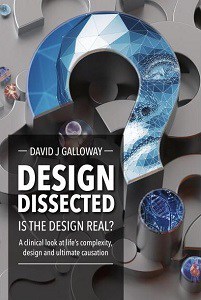
Design Dissected - Is the design real? by David J. Galloway
224 pages, Paperback.
Published by John Ritchie Ltd, 40 Beansburn, Kilmarnock.
ISBN 13. 978-1-914273-00-1.
The past few years have seen a number of books published on evidence of design in nature and how this is a compelling pointer to the Creator. This book is an interesting addition to the debate, and approaches these important issues from a different angle, namely reflections from a career in medicine. The author is a highly-regarded cancer surgeon who uses his life in surgery and the medical sciences to illustrate a number of important points which are overlooked by many who deny that there is any evidence for design (and hence by extension, a Designer) in nature.
The chapters in the book are short and each in turn focuses on a particular question, including the limits of science to explain everything, and the importance of using the correct methods for determining an original cause. The chapters are richly illustrated with examples from the author’s extensive and distingushed clinical career, with numerous interesting incidents and anecdotes which illustrate the points in question. In some chapters, the enthusiasm for these fascinating incidents runs away with itself, and arrival at the end left this reviewer, at times, wondering how we had got to the conclusion which is presented at the end of the chapter.
The middle section of the book, entitled ‘Layers of Perplexity’, discusses a number of areas of complexity within the medical and biological sciences. This includes genetics, the structure of the cells of the body, and details of how some important body systems work. This complexity is a compelling argument for design in living things. Whilst well written, the level of detail presented does require the reader to have at least some background in this area, as numerous technical terms are used (at times without explanation). As such, many readers may struggle with the level of detail in this section.
However, it is somewhat disappointing that the final conclusion of the book is: ‘The weight of evidence supporting real design brings the theistic view to centre stage’, which is a little underwhelming. It almost feels like it is missing the final chapter that deals with the issue of why this matters at all. There is surely much more which can be said in this regard, as the evidence of design in nature points to the Creator, to God Himself, and, by extension, to Christ as Saviour. This emphasis is almost completely missing from the book. In fact, it is difficult to find any reference to Christ at all. Surely, to be beyond academic interest, such a book must move beyond evidence merely for a ‘theistic view’ to a presentation of the Creator Himself.
Thanks to Keith Hunter, Killamarsh, for this review
| Cookie | Duration | Description |
|---|---|---|
| cookielawinfo-checkbox-advertisement | 1 year | Set by the GDPR Cookie Consent plugin, this cookie is used to record the user consent for the cookies in the "Advertisement" category . |
| cookielawinfo-checkbox-analytics | 11 months | This cookie is set by GDPR Cookie Consent plugin. The cookie is used to store the user consent for the cookies in the category "Analytics". |
| cookielawinfo-checkbox-functional | 11 months | The cookie is set by GDPR cookie consent to record the user consent for the cookies in the category "Functional". |
| cookielawinfo-checkbox-necessary | 11 months | This cookie is set by GDPR Cookie Consent plugin. The cookies is used to store the user consent for the cookies in the category "Necessary". |
| cookielawinfo-checkbox-others | 11 months | This cookie is set by GDPR Cookie Consent plugin. The cookie is used to store the user consent for the cookies in the category "Other. |
| cookielawinfo-checkbox-performance | 11 months | This cookie is set by GDPR Cookie Consent plugin. The cookie is used to store the user consent for the cookies in the category "Performance". |
| elementor | never | This cookie is used by the website's WordPress theme. It allows the website owner to implement or change the website's content in real-time. |
| viewed_cookie_policy | 11 months | The cookie is set by the GDPR Cookie Consent plugin and is used to store whether or not user has consented to the use of cookies. It does not store any personal data. |